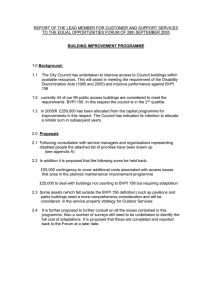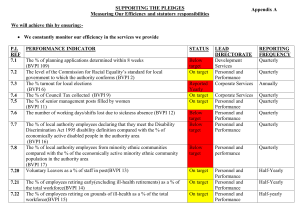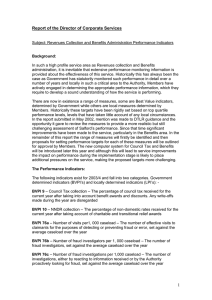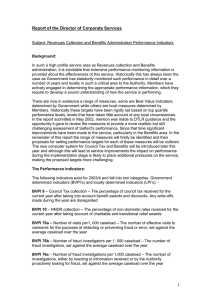TO TITLE: PART 1
advertisement
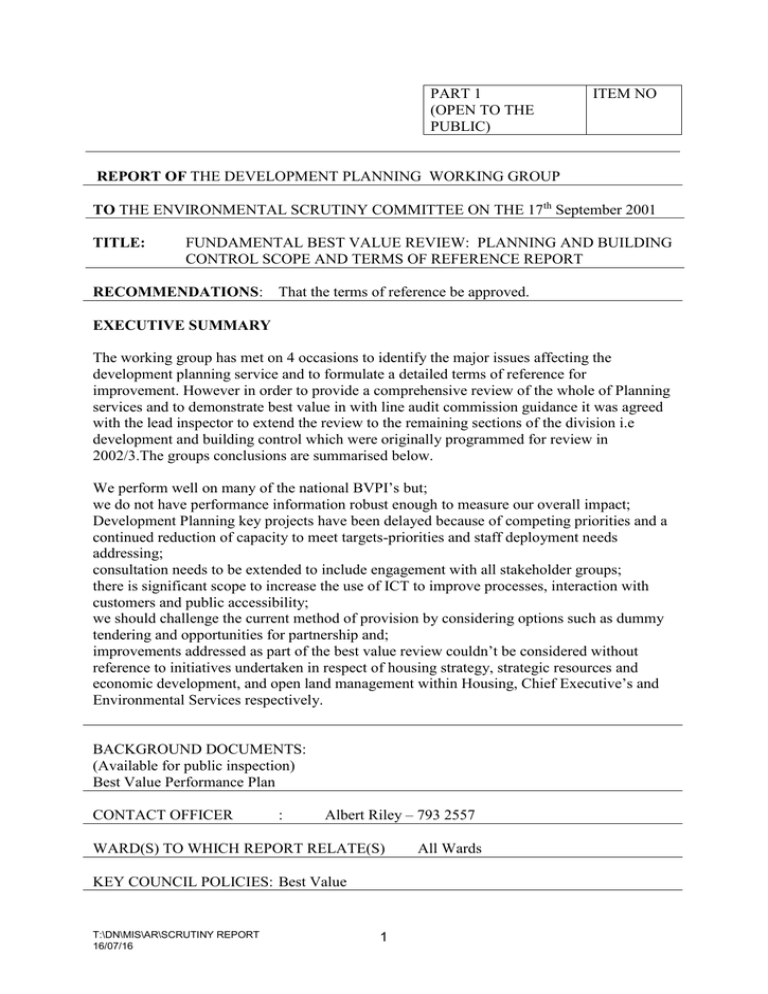
PART 1 (OPEN TO THE PUBLIC) ITEM NO REPORT OF THE DEVELOPMENT PLANNING WORKING GROUP TO THE ENVIRONMENTAL SCRUTINY COMMITTEE ON THE 17th September 2001 TITLE: FUNDAMENTAL BEST VALUE REVIEW: PLANNING AND BUILDING CONTROL SCOPE AND TERMS OF REFERENCE REPORT RECOMMENDATIONS: That the terms of reference be approved. EXECUTIVE SUMMARY The working group has met on 4 occasions to identify the major issues affecting the development planning service and to formulate a detailed terms of reference for improvement. However in order to provide a comprehensive review of the whole of Planning services and to demonstrate best value in with line audit commission guidance it was agreed with the lead inspector to extend the review to the remaining sections of the division i.e development and building control which were originally programmed for review in 2002/3.The groups conclusions are summarised below. We perform well on many of the national BVPI’s but; we do not have performance information robust enough to measure our overall impact; Development Planning key projects have been delayed because of competing priorities and a continued reduction of capacity to meet targets-priorities and staff deployment needs addressing; consultation needs to be extended to include engagement with all stakeholder groups; there is significant scope to increase the use of ICT to improve processes, interaction with customers and public accessibility; we should challenge the current method of provision by considering options such as dummy tendering and opportunities for partnership and; improvements addressed as part of the best value review couldn’t be considered without reference to initiatives undertaken in respect of housing strategy, strategic resources and economic development, and open land management within Housing, Chief Executive’s and Environmental Services respectively. BACKGROUND DOCUMENTS: (Available for public inspection) Best Value Performance Plan CONTACT OFFICER : Albert Riley – 793 2557 WARD(S) TO WHICH REPORT RELATE(S) KEY COUNCIL POLICIES: Best Value T:\DN\MIS\AR\SCRUTINY REPORT 16/07/16 1 All Wards DETAILS 1. Scope of the Review Development Planning encompasses; The preparation and review of the Unitary Development Plan including consideration of regional issues in conjunction with AGMA and the Regional development agency, as well as advising and guiding potential developers and other interested parties; The strategic development and delivery of specific physical generation projects through consultants and contractors, together with the associated monitoring, marketing and consultation e.g. Chapel Street corridor; steam coal and canal. Input to the development and implementation of corporate regeneration initiatives e.g. new deal for communities, SRB2 and 3. Information and research in respect of census data, unemployment, housing, planning applications and support information to strategy and resources within Chief Executives and; Establishing the corporate framework for environmental sustainability Local agenda 21, Environment and Countryside strategy. Building Control encompasses; The determination of applications for Building Regulations approval including carrying out detailed site inspections; Processing of Initial Notices from private sector Approved Inspectors; The enforcement of the legislation associated with Building Control; Provision of building surveys for the City Council services Surveying, inspection and making safe or arranging the removal of dangerous structures and ruinous and dilapidated buildings; Operation of a 24 hour emergency call-out service to deal with dangerous structures and other major incidents; Administration and supervision of the demolition of buildings; The securing of unsafe buildings to protect the public and preserve public amenity; Provision of advice on asbestos removal associated with the demolition of buildings; Management of the security of Council owned dilapidated buildings; Specification, preparation, pricing and supervision and implementation of demolition contracts for City Council services. The undertaking of site surveys and the administration of the licensing functions in respect of fire safety, public safety and the structural stability of licensed premises; The carrying out of site surveys and the administration of legislation relating to the control, management and safety of sports grounds; Undertaking of building surveys to assess facilities and access for disabled persons; Dealing with service complaints and feedback. Development Control encompasses; The provision of general advice and guidance on development and related matters; The provision of pre-planning application advice; Consulting the public T:\DN\MIS\AR\SCRUTINY REPORT 16/07/16 2 and interested parties – including statutory consultees; Assessing planning applications to ensure compliance with planning policies contained in the development plan The handling of planning and associated appeals and appearing at public inquiries; Responding to search enquiries; The processing, considering and negotiating, where appropriate, improvements which add value to the outcome of planning, advertisement and associated applications; Deciding, via delegated powers, or making recommendations on planning, advertisement or associated applications to members of the Planning and Transportation Regulatory Panel; Investigating alleged breaches of control; Preparing legal agreements and securing implementation; Dealing with service complaints and feedback. Staff, Cost and Income Overall 55.7 F.T.E. staff at a cost of £2.423 million and income of £1.142 million Development Planning 25.5 F.T. E (excluding vacancies) plus 3 seconded (1 at NWRA in Wigan and 2 with SAL1) staff at a cost of £1.02 million per annum currently provide this service. Building Control 17.5 FTE plus one seconded and two outstationed administrative staff. The total cost for the service was £801,906 (2000/2001) whilst income over that period totalled £508,388. Development Control 12.7 FTE including an enforcement officer, Building Conservation Officer and a Graduate Planner. There are two vacancies (A Planning Technician and Trainee Planning Technician). The total cost for the service was £601,205 (2000/2001), whilst income totalled £633,520 for this period. Linked Reviews The service is still in a state of flux as four previously separate sections i.e. Forward and Development Planning, Development and Building Control have been merged under two new section heads from April 2001. The review will exclude the G.M. Geological unit (funded by AGMA) and the Red Rose Forest team (funded by the Countryside Agency and six G.M. authorities), which the City Council leads from within the Development Planning section and is programmed for review in 2003/04. This review can be linked with the Regeneration review planned for Year 3 and 5 2002/03 and2004/5 covering Strategy & Resources, Economic Development, Pathfinder and Housing strategy within the thematic review in Housing and Chief Executive’s. T:\DN\MIS\AR\SCRUTINY REPORT 16/07/16 3 2. Review Context We need to consider how this review fits with corporate strategy, focus on services as users’ experience them, utilising an evidence based approach to provide a step change in the way services are planned and delivered. Consequently the Assistant Director and the group concluded that whilst the B.V. review was scheduled to cover development planning only in 2001/2 it would be more appropriate to consider the whole of the Planning and Building Control functions which would take a more rounded view of the whole service and provide a basis for improvement on a settled structure and avoid complications arising from the transfer of functions between the 4 former sections. This means bringing forward the commencement of the Development and Building Control review from 2002/3 this has been agreed with the B.V. inspectorate who will undertake an informal inspection at the end of 2001/2. This service contributes particularly to objectives 4 to 10 within the strategic plan in respect of contributions to employment, recreation, community safety, investment, a sustainable environment and promotion of the City as a place of national importance. Building and Development Control contribute in respect of the physical environment, community safety, ensuring buildings are properly constructed and ensuring the City Council’s responsibilities as Local Planning Authority and Building Control Authority are fulfilled The Development Control service is closely linked with Development Planning. In addition, the services have extensive links with other Development Services functions such as Traffic and Transportation, Drainage, Estates, the Greater Manchester Geological Unit and other Council Departments such as Chief Executives (strategy and resources and economic development), Environmental Services (Pollution Control and Aboricultural services). There are also links with external bodies such as the Environment Agency and the AGMA units. Although there is a performance management framework in place, improvement is required. Overall we do not have performance information robust enough to measure our overall impact on the outcomes from Development Planning projects and strategy. In relation to Development Control, for example, the speed of determination of planning applications is planned and monitored, however, measures for the monitoring and evaluation of the quality of the outcome of the process needs to be established. A number of Development Planning Key projects have been delayed because of competing priorities and a continued reduction of capacity to meet targets in work programmes. This service has a high impact on the built and natural environment and there is potential for service improvement. The Building and Development Control Services have a great deal of contact with customers. Whilst some customer consultation has taken place, and a user group T:\DN\MIS\AR\SCRUTINY REPORT 16/07/16 4 established, this needs to be extended to include engagement with all stakeholder groups. In terms of efficiency and cost effectiveness, the services are heavily reliant on ICT. There is, however, significant scope to increase the use of ICT to improve processes, interaction with customers and public accessibility. Performance indicators There are 7 BVPI’s associated with this area of work and included in the BVPP 2001/2 *BVPI 106 ‘% of new homes built on previously developed land’ Current: 87% Target 2004/05: 87% DLTR Target: 60% BVPI 107 Planning costs/head of population Current: £ 5.14 Target: Non Specified+ 9th lowest in 21 family authorities Compared to Top Quartile Metropolitan Authorities: £4.61 1999/00. *BVPI 108 Number of Departures from Statutory Plan as % of permissions granted Current: 0% Target 2004/05: 0% BVPI 109 The percentage of planning applications determined within 8 weeks Current: 76.4% Target: 80% Compared to Top Quartile Metropolitan Authorities: 83% 1999/00 BVPI 110 Average time to determine all planning applications Current: 8.5 weeks Target: 10.5 weeks BVPI 111 The % of applicants satisfied with the service Current: 87% Target: 90% BVPI 112 Score against a checklist of planning best practice – 5 out of 10 Local P.I.’s The processing of at least 70% of Building Regulations applications within the statutory period The carrying out of all Building Regulations site inspections within the statutory period and ensuring new buildings are accessible to disabled people, environmentally and energy efficient and suitable for occupation in respect of health and safety Responding to all reports of derelict properties within 24 hours of receiving the call Responding to all reports of dangerous buildings within 2 hours of receiving the call (* There are no national top quartile targets for these indicators) (+ Targets not specified because of reservations in respect of the accuracy of financial information) T:\DN\MIS\AR\SCRUTINY REPORT 16/07/16 5 3. Terms of Reference General To ensure that the Planning and Building Control service reflects best value and in general: Promotes and involves members in a health check on current services in comparison with other providers and customer requirements Determines the most economic, effective and equitable method of delivery reflecting service improvements and cost Produces an action plan for implementation Determine customer perception of the range of services provided, encouraging involvement, accessibility and incorporating customer feedback to improve the way we undertake service delivery. Identify and review the services linkages with other parts of the Council to facilitate structural cohesion and communication between partners. Evaluate the impact of staffing and information technology resources on the services capacity to meet deadlines and achieve optimum efficiency in order to improve responsiveness and the timely provision of advice. Particular Development Planning: Ascertain the efficiency and competitiveness of the service with a view to improving cost and quality compared to others Consider the cessation or curtailment of non-statutory services to redirect, where possible, resources to services with a greater priority. Building Control: Assess how best to improve speed of building regulations applications and provide a high quality service within the income recovered through competitive charges? Identify measures to compete effectively with private sector Approved Inspectors for building regulations applications? Evaluate whether partnering for the checking of building regulations applications is an appropriate development. Improve the City Council’s response and management requirements for the securing and demolition of buildings Development Control: Identify how to build upon the improvement in the speed of processing planning applications and further improve the quality of development; Identify means for the measurement of “adding value” to development for which planning permission is granted in order to assess improvement in the quality of outcome. T:\DN\MIS\AR\SCRUTINY REPORT 16/07/16 6 Evaluate whether the current approach to planning enforcement is efficient, effective, economic and equitable; Assess whether entering into a partnership with the GMGU would be cost effective, improve the quality of the outcome and improve customer service. Evaluate whether the current decision making arrangements can be changed to improve the accessibility of agents, applicants and the public and whether the arrangements to ensure probity are acceptable? These key issues can be actioned by undertaking: Consultation with staff and our internal and external partners and customers particularly Housing, Chief Executive’s, statutory consultees and internal consultees such as Traffic and Transportation and Environmental Services. Comparison with the practices of others. Visiting and networking with other authorities, engaging a “Critical Friend”. Challenge through analysis of current arrangements such as; staffing deployment in relation to Development Services and other directorates. Performance management by the extension of the use of timesheets, systems to capture volumes of work data and development of local performance indicators. Challenge the current method of provision. by competition through such considerations as dummy tendering, opportunities for partnership, and exploring the opportunities for modernisation through the greater utilisation of e- government. 4. Resources Nigel Powell– Team Leader Planning Officers Business Service Manager Link Officer BVPT Develop “Critical Friend” relationship with Sefton MBC and approach Warrington and Oldham Customer representative Trade Union representative 20 days/Annum 220 days/Annum 35 days/ Annum 45 days/ Annum Training and Research Further costs may be identified in this area as the review unfolds and a view on their priority will be taken at that time. Timescale April 2001 to March 2003 5. Work Programme A programme will be developed and reported to the next meeting of the panel/committee Interim reporting arrangements and panel meetings to be decided by the committee. T:\DN\MIS\AR\SCRUTINY REPORT 16/07/16 7
